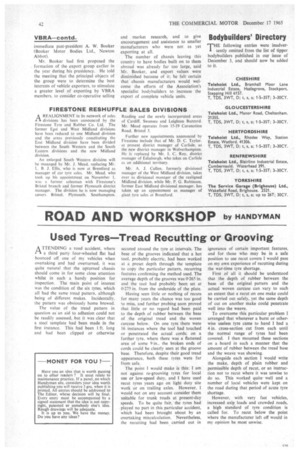ROAD AND WORKSHOP by HANDYMAN
Page 44

If you've noticed an error in this article please click here to report it so we can fix it.
Used Tyres—Tread Recutting or Grooving
ATTENDING a road accident, where a third party four-wheeled fiat had bounced off one of my vehicles when overtaking and had overturned, it was quite natural that the upturned chassis should come in for some close attention whilst in such a handy position for inspection. The main point of interest was the condition of the six tyres. which all had the same tread pattern, although being of different makes. Incidentally, the pattern was obviously home brewed.
The value of the tread pattern in question as an aid to adhesion could not be readily assessed, but it was clear that a steel template had been made in the first instance. This had been 1 ft. long and had been clipped or otherwise secured around the tyre at intervals. The base of the grooves indicated that a hot tool, probably electric, had been worked at a preset depth through the template to copy the particular pattern, recurring features confirming the method used. The average depth of the grooves was 0.265 in. and the tool had probably been set at 0.275 in. from the underside of the plate.
Having seen little or nothing of recuts for many years the chance was too good to miss, and further probing soon proved that little or no regard had been paid to the depth of rubber between the base of the original tread and the woven carcase below. On one tyre there were 16 instances where the tool had touched or penetrated the actual cords; on a further tyre. where there was a flattened area of some 9 in., the broken ends of cords could be clearly seen at the groove base. Therefore, despite their good tread appearance, both these tyres were far from safe.
The point I would make is this; I am not against re-grooving tyres for local use or low-speed duty, and I have used recut tyres years ago on light duty site work or on trailing axles. However. I would not on any account consider them suitable for trunk roads at present-day speeds. To be quite fair, the tyres had played no part in this particular accident, which had been brought about by an overtaking miscalculation. Nevertheless, the recutting had been, carried out in ignorance of certain important features, and for those who may be in a safe position to use recut covers I would pass on my own experience of recutting during the war-time tyre shortage.
First of all it should be understood that the depth of rubber between the base. of the original pattern and the actual woven carcase can vary to such an extent that a recut on one make could be carried out safely, yet the same depth of cut on another make could penetrate well into the weave.
To overcome this particular problem I arranged that whenever a burst or otherwise useless tyre came to hand I had a 4 in. cross-section cut from each until the normal range of tyres had been covered. I then mounted these sections on a board in such a 'manner that the amount of rubber between the tread base and the weave was showing.
Alongside each section I would write the make, depth of plain rubber and permissible depth of recut, or an instruction not to recut where it was unwise to do so. This worked quitewell and a number of local vehicles were kept on the road during that period of acute tyre shortage.
However, with very fast vehicles, increased axis loads and crowded roads, a high standard of tyre condition is called for. To recut below the point where the manufacturer left off would in my opinion be most unwise,












































































































